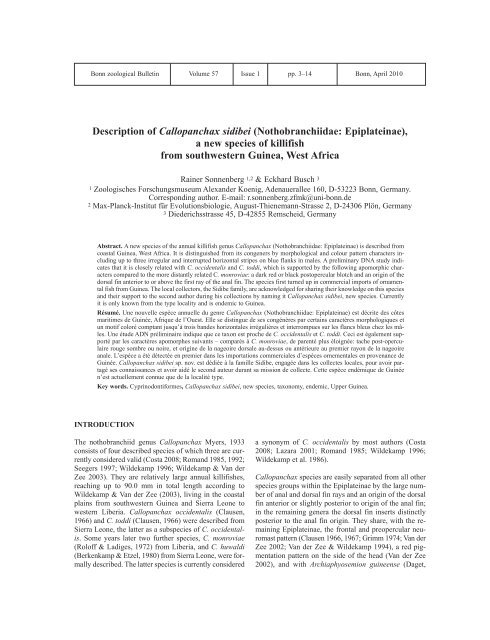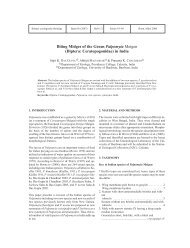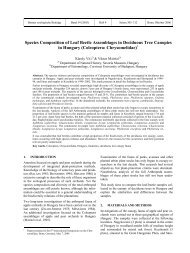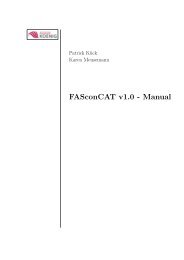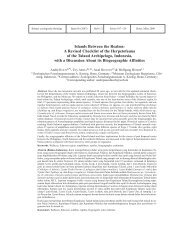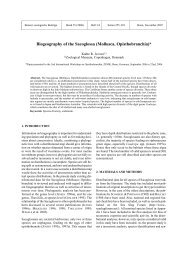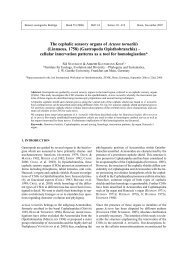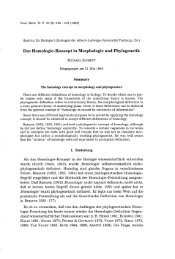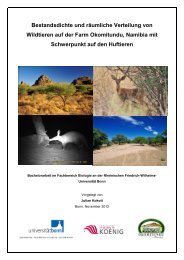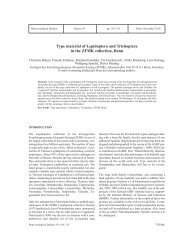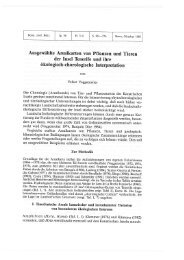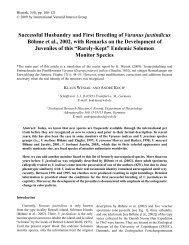Nothobranchiidae: Epiplateinae
Nothobranchiidae: Epiplateinae
Nothobranchiidae: Epiplateinae
Create successful ePaper yourself
Turn your PDF publications into a flip-book with our unique Google optimized e-Paper software.
Bonn zoological Bulletin Volume 57 Issue 1 pp. 3–14 Bonn, April 2010<br />
Description of Callopanchax sidibei (<strong>Nothobranchiidae</strong>: <strong>Epiplateinae</strong>),<br />
a new species of killifish<br />
from southwestern Guinea, West Africa<br />
Rainer Sonnenberg 1,2 & Eckhard Busch 3<br />
1 Zoologisches Forschungsmuseum Alexander Koenig, Adenauerallee 160, D-53223 Bonn, Germany.<br />
Corresponding author. E-mail: r.sonnenberg.zfmk@uni-bonn.de<br />
2 Max-Planck-Institut für Evolutionsbiologie, August-Thienemann-Strasse 2, D-24306 Plön, Germany<br />
3 Diederichsstrasse 45, D-42855 Remscheid, Germany<br />
Abstract. A new species of the annual killifish genus Callopanchax (<strong>Nothobranchiidae</strong>: <strong>Epiplateinae</strong>) is described from<br />
coastal Guinea, West Africa. It is distinguished from its congeners by morphological and colour pattern characters including<br />
up to three irregular and interrupted horizontal stripes on blue flanks in males. A preliminary DNA study indicates<br />
that it is closely related with C. occidentalis and C. toddi, which is supported by the following apomorphic characters<br />
compared to the more distantly related C. monroviae: a dark red or black postopercular blotch and an origin of the<br />
dorsal fin anterior to or above the first ray of the anal fin. The species first turned up in commercial imports of ornamental<br />
fish from Guinea. The local collectors, the Sidibe family, are acknowledged for sharing their knowledge on this species<br />
and their support to the second author during his collections by naming it Callopanchax sidibei, new species. Currently<br />
it is only known from the type locality and is endemic to Guinea.<br />
Résumé. Une nouvelle espèce annuelle du genre Callopanchax (<strong>Nothobranchiidae</strong>: <strong>Epiplateinae</strong>) est décrite des côtes<br />
maritimes de Guinée, Afrique de l’Ouest. Elle se distingue de ses congénères par certains caractères morphologiques et<br />
un motif coloré comptant jusqu’à trois bandes horizontales irrégulières et interrompues sur les flancs bleus chez les mâles.<br />
Une étude ADN préliminaire indique que ce taxon est proche de C. occidentalis et C. toddi. Ceci est également supporté<br />
par les caractères apomorphes suivants – comparés à C. monroviae, de parenté plus éloignée: tache post-operculaire<br />
rouge sombre ou noire, et origine de la nageoire dorsale au-dessus ou antérieure au premier rayon de la nageoire<br />
anale. L’espèce a été détectée en premier dans les importations commerciales d’espèces ornementales en provenance de<br />
Guinée. Callopanchax sidibei sp. nov. est dédiée à la famille Sidibe, engagée dans les collectes locales, pour avoir partagé<br />
ses connaissances et avoir aidé le second auteur durant sa mission de collecte. Cette espèce endémique de Guinée<br />
n’est actuellement connue que de la localité type.<br />
Key words. Cyprinodontiformes, Callopanchax sidibei, new species, taxonomy, endemic, Upper Guinea.<br />
INTRODUCTION<br />
The nothobranchiid genus Callopanchax Myers, 1933<br />
consists of four described species of which three are currently<br />
considered valid (Costa 2008; Romand 1985, 1992;<br />
Seegers 1997; Wildekamp 1996; Wildekamp & Van der<br />
Zee 2003). They are relatively large annual killifishes,<br />
reaching up to 90.0 mm in total length according to<br />
Wildekamp & Van der Zee (2003), living in the coastal<br />
plains from southwestern Guinea and Sierra Leone to<br />
western Liberia. Callopanchax occidentalis (Clausen,<br />
1966) and C. toddi (Clausen, 1966) were described from<br />
Sierra Leone, the latter as a subspecies of C. occidentalis.<br />
Some years later two further species, C. monroviae<br />
(Roloff & Ladiges, 1972) from Liberia, and C. huwaldi<br />
(Berkenkamp & Etzel, 1980) from Sierra Leone, were formally<br />
described. The latter species is currently considered<br />
a synonym of C. occidentalis by most authors (Costa<br />
2008; Lazara 2001; Romand 1985; Wildekamp 1996;<br />
Wildekamp et al. 1986).<br />
Callopanchax species are easily separated from all other<br />
species groups within the <strong>Epiplateinae</strong> by the large number<br />
of anal and dorsal fin rays and an origin of the dorsal<br />
fin anterior or slightly posterior to origin of the anal fin;<br />
in the remaining genera the dorsal fin inserts distinctly<br />
posterior to the anal fin origin. They share, with the remaining<br />
<strong>Epiplateinae</strong>, the frontal and preopercular neuromast<br />
pattern (Clausen 1966, 1967; Grimm 1974; Van der<br />
Zee 2002; Van der Zee & Wildekamp 1994), a red pigmentation<br />
pattern on the side of the head (Van der Zee<br />
2002), and with Archiaphyosemion guineense (Daget,
4<br />
Rainer Sonnenberg & Eckhard Busch<br />
Table 1. List of specimens used for DNA sequencing with voucher sample number, collection locality, country, and GenBank accession<br />
numbers. Accession numbers with * are published in Murphy & Collier (1997), with ** in Sonnenberg & Busch (2009).<br />
Aquarium strain means that the origin in nature for this sample is unknown.<br />
Sample no. species Collection locality Country GenBank acc. no.<br />
OCC GB Callopanchax occidentalis aquarium strain Sierra Leone U73242*<br />
OCC1530 Callopanchax occidentalis SL 03/11, Malai Sierra Leone GU553007<br />
OCC1531 Callopanchax occidentalis SL 89, Teme Yellah Sierra Leone GU553008<br />
OCC1532 Callopanchax occidentalis SL 03/19, Magbenta Sierra Leone FJ872034**<br />
TOD1534 Callopanchax toddi GM 97/26, Takhori Guinea GU553009<br />
TOD1535 Callopanchax toddi GM 97/24, Mola Guinea GU553010<br />
cTOD1758 Callopanchax cf. toddi GM 97/3, Mangata Badjana Guinea GU553011<br />
SID1536 Callopanchax sidibei GM 97/2, Bombokore Guinea GU553012<br />
MON1533 Callopanchax monroviae L 97, Paynesville Liberia GU553013<br />
GER1381 Scriptaphyosemion geryi SL 03/9, Robis 1 Sierra Leone FJ872033**<br />
GUI1404 Archiaphyosemion guineense SL 93/37, Lenghe Curoh Sierra Leone FJ872031**<br />
Fig. 1. Map of Callopanchax collection localities in coastal West Africa. The letter T indicates the respective type localities, D<br />
indicates origin of Callopanchax DNA samples used in this study. Black square = C. occidentalis, white square = C. toddi, black<br />
circle = C. cf. toddi, white circle = C. huwaldi, black triangle = C. monroviae, white triangle = C. sidibei.<br />
Bonn zoological Bulletin 57 (1): 3–14 ©ZFMK
1954) and Scriptaphyosemion Radda & Pürzl,1987 a distinct<br />
constriction of the subdistal portion of the posterior<br />
arm of the parasphenoid (Costa 2009). The phylogenetic<br />
placement of Callopanchax within the <strong>Epiplateinae</strong> and<br />
its sister group relationship with Scriptaphyosemion is supported<br />
by molecular data (Murphy & Collier 1997; Murphy<br />
et al. 1999; Sonnenberg & Busch 2009).<br />
In 1992 a scientifically unknown Callopanchax species<br />
turned up in a commercial import of ornamental fish from<br />
Guinea to the Netherlands. Its distinctness was first recognized<br />
by the unique colour pattern of this species (Busch<br />
1993; Wildekamp 1996; Wildekamp & Van der Zee 2003)<br />
and was later supported by a study based on molecular data<br />
(Murphy et al. 1999). During several research trips in<br />
Guinea, the second author was able to collect specimens<br />
of this undescribed Callopanchax, which is herein described<br />
as Callopanchax sidibei, new species.<br />
MATERIAL AND METHODS<br />
The specimens on which the following description is based<br />
were deposited in the ichthyological collections of the<br />
Musée Royal de l’Afrique Centrale (MRAC), Tervuren,<br />
Belgium, and the Zoologisches Forschungsmuseum<br />
Alexander Koenig, Bonn, Germany (ZFMK). Comparative<br />
material of the other species is listed below.<br />
Measurements and counts are made as indicated in Sonnenberg<br />
& Busch (2009), transverse scale count was made<br />
between the anterior insertion of the pelvic fin and dorsal<br />
fin; the very small scales on the belly were not count-<br />
A new Callopanchax from Guinea<br />
Table 2. Uncorrected p-distances for the mitochondrial LSU sequences with pairwise exclusion of missing data among nine samples<br />
of Callopanchax, one of Archiaphyosemion, and one of Scriptaphyosemion. The upper triangle contains the linear geographic<br />
distances between the different collection localities of the sequenced Callopanchax specimens, except for OCC GB, which is according<br />
to Murphy et al. (1999) an aquarium strain of unknown origin.<br />
sample OCC GB OCC OCC OCC TOD TOD cTOD SID MON GER<br />
1530 1531 1532 1534 1535 1758 1536 1533 1381<br />
OCC 1530 1.7 – 204 km 40 km 196 km 64 km 106 km 95 km 370 km –<br />
OCC 1531 1.5 1.7 – 185 km 396 km 245 km 301 km 289 km 175 km –<br />
OCC 1532 1.9 1.3 1.5 – 230 km 103 km 144 km 132 km 340 km –<br />
TOD 1534 6.6 5.8 6.8 6.6 – 154 km 97 km 110 km 565 km –<br />
TOD 1535 5.9 5.2 6.2 6.0 1.7 – 57 km 43 km 418 km –<br />
cTOD 1758 6.8 5.6 6.6 6.4 2.7 1.5 – 14 km 472 km –<br />
SID 1536 7.6 6.7 7.5 7.1 7.5 6.5 6.2 – 458 km –<br />
MON 1533 14.2 12.3 12.8 13.1 12.5 12.5 12.5 13.1 – –<br />
GER 1381 9.6 9.7 8.7 9.3 9.5 9.7 10.1 10.6 14.2 –<br />
GUI 1404 11.9 10.8 11.3 10.8 10.8 10.8 11.6 12.4 14.8 9.4<br />
ed. Digital X-ray images of the types and some specimens<br />
of the comparative material used for unpaired fin ray and<br />
vertebrate counts were made with a Faxitron LX-60 Digital<br />
Specimen Radiography System at the ZFMK. Caudal<br />
fin ray counts were only made from X-ray images and include<br />
all visible rays.<br />
We prepared a preliminary DNA dataset of a fragment of<br />
the mitochondrial large ribosomal subunit (16S rDNA) for<br />
a small number of specimens, including three of C. occidentalis<br />
from Sierra Leone, one sequence of C. occidentalis<br />
from GenBank (accession number U73242, Murphy<br />
& Collier 1997), two specimens of C. toddi and one of C.<br />
cf. toddi from Guinea, one specimen of each C. monroviae<br />
and C. sidibei, new species, and, as an outgroup, Archiaphyosemion<br />
guineense and Scriptaphyosemion geryi<br />
(Lambert, 1958). The latter two are the type species of the<br />
respective genera. Specimens are listed with locality information<br />
and GenBank accession number in Table 1,<br />
methods for DNA extraction, amplification and sequencing<br />
of the 16S rDNA fragment are provided in Sonnenberg<br />
& Busch (2009), where also some of the sequences<br />
were published. Resulting sequences were aligned with<br />
ClustalX 1.8 (Thompson et al. 1997) and checked by eye<br />
in BioEdit 7.0.5.3 (Hall 1999). Sequences were tested for<br />
the anti-G bias characteristic of mitochondrial DNA<br />
(Zhang & Hewitt 1996). Uncorrected p-distances with the<br />
pairwise deletion of missing data were calculated in Mega<br />
4.1 beta 3 (Tamura et al. 2007) and are given in Table 2.<br />
Analyses of sequence data were made with PAUP 4.0b10<br />
(Swofford 1998) by maximum parsimony and with Mr-<br />
Bayes 3.1.2 (Huelsenbeck & Ronquist 2001) by a<br />
Bonn zoological Bulletin 57 (1): 3–14 ©ZFMK<br />
5
6<br />
Bayesian approach. Maximum parsimony analyses were<br />
done with the exclusion of uninformative positions, gaps<br />
were coded as a fifth character state, and heuristic tree<br />
searches were performed with random addition of sequences<br />
for 1,000 replicates. Bootstrapping was performed<br />
with the random addition of sequences for 100 replicates<br />
and 10,000 bootstrap replicates. Bayesian analyses were<br />
performed with the number of generations set to<br />
10,000,000, with sampling every 1,000 generations, and<br />
the results of the first 1,000,000 generations were discarded<br />
as a burn-in time after checking that the runs had<br />
reached the stationary phase at this point of the analysis.<br />
We performed two runs for this dataset, one with two parameter<br />
models (Nst 2) and one with six parameter models<br />
(Nst 6), settings for rate=gamma and ngammacat=4.<br />
We chose to perform these two runs to check if there are<br />
serious differences in the results due to potential underor<br />
overparametrization, especially because of the small<br />
dataset with large genetic divergences (Table 2). We consider<br />
only nodes with ≥ 75 % bootstrap support and ≥ 95<br />
% posterior probabilities as supported by the data.<br />
Additional information for the collection localities in Table<br />
1 can be found in the comparative material list. Collection<br />
points in Figure 1 are from museum collection data<br />
Rainer Sonnenberg & Eckhard Busch<br />
Fig. 2. A) Holotype of Callopanchax sidibei, male, ZFMK 41613, 58.5 mm SL. B) Paratype of Callopanchax sidibei, male,<br />
ZFMK 41614, 47.0 mm SL. C) Callopanchax sidibei, male with red dots in the anal and caudal fin, not preserved. D) Paratype of<br />
Callopanchax sidibei, female, ZFMK 41615, 55.4 mm SL.<br />
as accessed via Fishbase (Froese & Pauly 2009), from Huber<br />
(2007), and collection data of the second author. We<br />
adopted, as a species concept, the definition by Moritz et<br />
al. (2000) which „...recognize as species geographically<br />
bounded sets of populations that are distinct for morphological<br />
traits or are reproductively isolated from congeners,<br />
with or without corresponding molecular divergence...“.<br />
RESULTS<br />
Callopanchax sidibei, new species<br />
(Fig. 2A–D, Table 3)<br />
Roloffia sp. „Guinea, CI 92“: Busch (1993), p. 64.<br />
Fundulopanchax species aff. toddi: Wildekamp (1996), pp.<br />
212–213.<br />
Callopanchax sp. Guinea: Wildekamp & Van der Zee<br />
(2003), pp. 381–383.<br />
Callopanchax huwaldi (non Berkenkamp & Etzel, 1980):<br />
Neumann (2005), misidentification in fig. caption p. 48.<br />
Holotype. ZFMK 41613, male, 58.5 mm SL, Guinea,<br />
Guinée maritime, Kindia region, small river and adjacent<br />
pools and ditches in a secondary forest (9°32.71’ N,<br />
Bonn zoological Bulletin 57 (1): 3–14 ©ZFMK
13°14.51’W), close to the small village Bombokoré, about<br />
3 km from the closest larger village Fandi, collection locality<br />
GM 08/2, E. Busch and B. Wiese, 25.10.2008, Figure<br />
2A.<br />
Paratypes. ZFMK 41614–41615, 1 male, 47.0 mm SL,<br />
1 female, 55.4 mm SL, paratopotypes, collected with holotype,<br />
Figure 2B & D.<br />
ZFMK 41616–41628, 5 males, 8 females, 39.0–58.9 mm<br />
SL, paratopotypes, collected with holotype.<br />
MRAC 2010–02–P–1–5, 2 males, 3 females, 46.3–59.9<br />
mm SL, paratopotypes, collected with holotype.<br />
Diagnosis. Callopanchax sidibei (Fig. 2A–D) is, together<br />
with C. toddi (Fig. 3A–F) and C. occidentalis (Fig. 4A<br />
& B), distinguished from C. monroviae (Fig. 5A–C) by<br />
insertion of first dorsal fin ray slightly anterior to first anal<br />
fin ray versus a posterior insertion. The former three<br />
species are also distinguished from C. monroviae by a dark<br />
red to black postopercular blotch above insertion of pectoral<br />
fin versus absence and a dark or black blotch on the<br />
A new Callopanchax from Guinea<br />
Table 3. Morphometric and meristic data of Callopanchax sidibei. All measurements in percentages of standard length except standard<br />
length in mm. Fin ray counts were made on X-rays and include all visible rays. SD = standard deviation.<br />
Holotype ` Types ´ Types all Types all Types all Types SD<br />
mean mean mean range<br />
Standard length 58.5 48.4 50.7 49.7 39.0–59.9 6.8<br />
Total length 124.8 124.6 122.7 123.5 117.1–132.5 4.5<br />
Head length 28.4 29.2 29.1 29.1 27.7–30.5 0.9<br />
Predorsal fin distance 56.7 57.6 60.1 59.0 55.4–63.2 1.9<br />
Prepelvic fin distance 54.1 52.0 52.7 52.4 49.1–56.6 2.0<br />
Preanal fin distance 62.9 62.5 64.2 63.5 60.1–68.9 2.3<br />
Greatest body depth 24.3 23.3 22.3 22.7 20.0–25.8 1.6<br />
Depth of caudal peduncle 13.3 13.2 12.1 12.6 10.7–14.6 1.0<br />
Length of caudal peduncle 23.1 21.6 22.1 21.9 17.8–25.1 1.7<br />
Base of dorsal fin 28.3 28.2 25.7 26.8 23.5–30.7 1.9<br />
Base of anal fin 23.2 23.1 18.2 20.3 17.6–24.6 2.6<br />
Eye diameter 7.2 6.8 6.8 6.8 6.1–7.6 0.4<br />
Interorbital distance 13.7 12.1 11.7 11.9 10.3–13.7 0.8<br />
Dorsal fin rays 19 19.8 19.8 19.8 19–21 0.8<br />
Anal fin rays 17 17.9 18.1 18.0 17–19 0.6<br />
Dorsal / anal fin position -2 -2.8 -3.2 -3.0 -2– -4 0.7<br />
Caudal fin rays 33 32.0 31.8 31.9 29–34 1.2<br />
Total number of vertebrae 33 33.1 32.6 32.8 32–34 0.7<br />
Vertebrae with pleural ribs 15 15.2 14.8 15.0 14–16 0.7<br />
Vertebrae with haemal spines 18 17.9 17.8 17.8 17–19 0.6<br />
Lateral line scales 34+4 33.2+3.8 33.1+3.5 33.1+3.6 32-34+3-5 0.9+0.6<br />
Transverse row of scales 12 11.2 10.8 11.0 10–13 0.8<br />
Scales around caudal peduncle 16 15.9 15.8 15.9 15–16 0.4<br />
anterior dorsal fin rays instead. The postopercular blotch<br />
is present in females of C. sidibei, C. occidentalis, and C.<br />
toddi but often only faint; the dark blotch on anterior dorsal<br />
fin in C. monroviae may not be visible in females. Callopanchax<br />
sidibei, C. occidentalis, and C. toddi males have<br />
an anal fin with a white or bluish-white margin and usually<br />
only a small number of red dots or blotches on fin<br />
center; no horizontal red band or only traces of red under<br />
the eye from lower lip to posterior border of opercle;<br />
postopercular red pigmentation on flank formed by up to<br />
three irregular red horizontal bands interrupted into blotches.<br />
Males of C. monroviae have a dark or dark-red anal<br />
fin margin, proximal red dots, blotches or broad vertical<br />
streaks, and streaks between fin rays on distal part of anal<br />
fin; a more or less complete red band from snout under<br />
the eye and often extending on side to origin of pelvic fin;<br />
postopercular red pigmentation consists of incomplete<br />
rows of small red dots on anterior side and less and irregularly<br />
distributed red dots or a pattern of incomplete and<br />
irregular vertical stripes on posterior side. Males of C.<br />
sidibei can also be distinguished from C. monroviae by<br />
Bonn zoological Bulletin 57 (1): 3–14 ©ZFMK<br />
7
8<br />
body colouration which is mainly blue to blue-green on<br />
sides and dorsally often a golden sheen to the anterior, versus<br />
anteriorly pale blue to blue-green and dorsal and posterior<br />
half of body reddish, reddish-brown or orange, or<br />
in the blue form body completely pale to grey-blue (Fig.<br />
5A–C).<br />
Rainer Sonnenberg & Eckhard Busch<br />
Fig. 3. A) Male of Callopanchax cf. toddi, Mangata Badjana, Guinea, collection locality GM 08/3 (= GM 97/3). B) Female of<br />
Callopanchax cf. toddi, Mangata Badjana, Guinea, collection locality GM 08/3 (= GM 97/3). C) Male of Callopanchax toddi, Mola,<br />
Guinea, collection locality GM 09/17 (= GM 08/4 & GM 97/24). D) Female of Callopanchax toddi, Mola, Guinea, collection<br />
locality GM 09/17 (= GM 08/4 & GM 97/24). E) Male of Callopanchax toddi, Lamayah, Guinea, collection locality GM 08/11.<br />
F) Male of Callopanchax toddi, Takhori, Guinea, collection locality GM 09/12 (= GM 08/9 & GM 97/26).<br />
Callopanchax sidibei can be distinguished from males of<br />
C. occidentalis and C. toddi by up to three irregular and<br />
interrupted horizontal stripes on flanks, an absence of vertical<br />
dark red or reddish-brown stripes or broad blotches<br />
on sides and a mainly blue to blue-green body colour versus<br />
dark brown, brown or red vertical stripes or blotches<br />
Bonn zoological Bulletin 57 (1): 3–14 ©ZFMK
A new Callopanchax from Guinea<br />
Fig. 4. A) Male of Callopanchax occidentalis, Malai, Sierra Leone, collection locality SL 03/11 (= SL 93/54). B) Female of<br />
Callopanchax occidentalis, Malai, Sierra Leone, collection locality SL 03/11 (= SL 93/54).<br />
Fig. 5. A) Male of Callopanchax monroviae, aquarium strain<br />
from Paynesville, Liberia, collection locality L 97, red form. B)<br />
Male of Callopanchax monroviae, aquarium strain from Paynesville,<br />
Liberia, collection locality L 97, blue form. C) Female<br />
of Callopanchax monroviae, aquarium strain from Paynesville,<br />
Liberia, collection locality L 97.<br />
and a more reddish brown or copper to golden body colour<br />
with blue only on ventral side. Exceptions are populations<br />
with rare blue males in C. occidentalis and, if valid, C.<br />
huwaldi, which show the same pattern as the ‘typical’ form<br />
but lack orange and yellow pigments, but not the red pigmentation<br />
and the dark vertical stripes or blotches on posterior<br />
side (e.g. Berkenkamp & Etzel 1980; Eberl 1999,<br />
pictures of C. occidentalis from Mabeimah on p. 65;<br />
Roloff 1976).<br />
Large males of C. sidibei show only a slightly rugged anal<br />
and dorsal fin border and rounded or slightly pointed fin<br />
tips versus more pronounced rugged fin borders in most<br />
C. occidentalis and C. toddi, especially the posterior tip<br />
of the anal fin, which can show filamentous extensions.<br />
Females of C. sidibei can be distinguished from C. occidentalis<br />
and C. toddi females by mid-laterally blue to bluegreen<br />
coloured scales and the absence of the dark brown<br />
vertical stripes or blotches, similar as in males versus blue<br />
to blue-green coloured scales only on anterior side, often<br />
with short vertical dark blotches dorsally on side. They<br />
are distinguished from females of C. monroviae by their<br />
pigmentation pattern of red horizontal stripes with broad<br />
blotches versus more regular horizontal rows of small red<br />
dots and the absence of metallic blue to blue-green<br />
coloured scales on side in C. monroviae.<br />
Description. See Fig. 2A–D for general appearance and<br />
Table 3 for morphometric and meristic data of the types.<br />
Callopanchax sidibei (Fig. 2A–D) shares with its congeners<br />
the following combination of diagnostic characters<br />
within the <strong>Epiplateinae</strong>: large and robust species, dorsal<br />
and anal fins with a high number of fin rays, origin of dorsal<br />
fin close to origin of anal fin. A species with strong<br />
sexual dimorphism, adult males usually larger, with larger<br />
fins and more colourful than females. Maximum ob-<br />
Bonn zoological Bulletin 57 (1): 3–14 ©ZFMK<br />
9
10<br />
served SL in males 59.9 mm, in females 59.0 mm. Body<br />
cylindrical, outline from tip of snout to posterior end of<br />
dorsal and anal fin convex, on caudal peduncle dorsally<br />
and ventrally slightly concave to nearly straight. Greatest<br />
body depth approximately at half distance between origins<br />
of pectoral and pelvic fins.<br />
Snout slightly pointed, mouth directed upwards, lower jaw<br />
longer than upper jaw; many irregularly distributed unicuspid,<br />
slightly curved teeth of different size, a small number<br />
of larger ones on the outer row of upper and lower jaw.<br />
Closed frontal neuromast system in one groove, preopercular<br />
neuromast system with 5 pores.<br />
Total number of vertebrae 32–34, number of vertebrae<br />
with pleural ribs 14–16, with haemal spines 17–19. The<br />
X-ray images indicate that in about half of the studied<br />
specimens the hypural plates are fused, as no gap or indication<br />
of overlap is visible.<br />
Fins in males slightly larger than in females, base of dorsal<br />
mean value 28.2 % of standard length (SL) in males<br />
versus 25.7 % SL, base of anal in males 23.1 % SL versus<br />
18.2 % SL in females. Dorsal and anal fin rounded or<br />
slightly pointed, no long filamentous extension, fin insertion<br />
in both sexes posterior to mid-body. In large adult<br />
males, dorsal and anal fin rays sometimes protrude from<br />
the fin membran, giving the impression of a rugged fin<br />
border. Papillae on anal fin rays in males. First 2–4 dorsal<br />
fin rays anterior of origin of anal fin. Dorsal fin rays<br />
19–21, anal fin rays 17–19. Caudal fin rounded or slightly<br />
truncated, 29–34 fin rays. The single specimen with 29<br />
caudal fin rays has a small gap between the anterior dorsally<br />
situated rays explaining the comparatively low value.<br />
Pectoral fin origin on ventral half of side, posterior of<br />
opercle, rounded, extending posteriorly, not reaching origin<br />
of pelvic fin. Pelvic fin small and slightly pointed, not<br />
or just reaching anal fin.<br />
Scales cycloid, body and head entirely scaled except<br />
throat, scales dorso-anteriorly larger then ventrally and<br />
posteriorly, frontal squamation of G-type, scales on lateral<br />
line 32-34 + 3-5 on caudal fin base, not all scales along<br />
lateral line with small grooves in center. Transverse row<br />
of scales above pelvic fin 10–13, circumpeduncular scale<br />
row 15–16.<br />
Live colouration. Males. (Fig. 2A–C) Dorsal from head<br />
to dorsal fin brown, some scales on back with red dots or<br />
scale borders, forming an irregular reticulated pattern to<br />
the end of the caudal peduncle; flanks blue to blue-green,<br />
dorsolaterally with a metallic copper or golden sheen on<br />
scales, belly blue to bluish-grey.<br />
Rainer Sonnenberg & Eckhard Busch<br />
Red pigmentation pattern on head posterior of the eye typical<br />
for <strong>Epiplateinae</strong> (Van der Zee 2002) with two posterior<br />
directed horizontal red stripes, originating from one<br />
point posterior of the eye to posterior border of opercle,<br />
and two more or less complete vertical stripes dorsally.<br />
On flanks three interrupted and irregular red stripes, upper<br />
and lower stripes only extending up to the posterior<br />
insertion of dorsal fin, only the middle stripe, positioned<br />
slightly above mid-line of body, extends to the end of the<br />
caudal peduncle, in some males the dorsolateral stripe only<br />
consists of a small number of red dots or red scale borders.<br />
Posterior of the opercle and above insertion of pectoral<br />
fin usually 2–3 scales in two neighbouring rows with<br />
broad black or dark red margin, forming a black or dark<br />
red blotch.<br />
Unpaired fins blue to blue-green, with white or, rarely, yellow-white<br />
margins and red submarginal stripe. Red pigmentation<br />
pattern on unpaired fins variable. Dorsal fin<br />
with red dots or short streaks between fin rays, below red<br />
submarginal band a whitish zone. Anal fin without or only<br />
with little red pigmentation beside submarginal red<br />
stripe, in some males a proximal row with a small number<br />
of red dots (Fig. 2C). Caudal fin in some males with<br />
red dots or blotches, lower white margin broader then upper<br />
and in some specimens slightly yellow-white. In males<br />
with a more rounded caudal fin shape marginal and submarginal<br />
stripes can be closed on posterior end of fin, in<br />
males with a more truncate fin shape they end on the posterior<br />
fin border (Fig. 2A–C). Pelvic fins bluish, with red<br />
submarginal and white marginal stripe, pectoral hyaline<br />
with a white or blue-white margin.<br />
Females. (Fig. 2D) Body brown to light brown, dorsally<br />
darker then ventrally, sometimes with a golden colour<br />
sheen on anterior side. Scales dorsally and laterally with<br />
dark border, forming a reticulate pattern. Lateral red pigmentation<br />
pattern similar to males, usually less pronounced<br />
and paler. Broad dark brown to brownish-grey<br />
lateral stripe from posterior border of operculum above<br />
origin of pectoral fin to posterior end of caudal peduncle<br />
on upper half. This stripe is not always visible and especially<br />
pronounced in stressed specimens. On upper half<br />
of opercle, posterior of the eye, extending along the dark<br />
stripe on the side irregularly distributed scales with metallic<br />
blue or blue-green colour, with the highest density anteriorly.<br />
Fins except pectoral light brown and slightly hyaline,<br />
unpaired fins with a whitish margin, on dorsal and<br />
caudal with pale red submarginal line. Dorsal and caudal<br />
fin with red dots, on dorsal sometimes restricted to fin<br />
base. Pectoral fin transparent with whitish to light blue<br />
margin.<br />
Bonn zoological Bulletin 57 (1): 3–14 ©ZFMK
Preserved in ethanol. Males. Head dark grey, body dark<br />
brown to grey, some traces of red dots and blotches on<br />
side, belly whitish, beige, or greyish, a ventral dark stripe<br />
posterior to level of pectoral fin insertion to anterior origin<br />
of anal fin. Fins pale grey with a dark submargin and<br />
small whitish margin, except caudal fin with a ventral<br />
broad and dorsal thin whitish margin, posterior border dark<br />
brown to reddish.<br />
Females. Head laterally and dorsally dark grey, chin with<br />
a dark blotch on ventral inner side of lower lip, body dorsally<br />
darker grey or brown, a dark stripe from posterior<br />
border of opercle to origin of caudal fin, dark stripe dorsally<br />
with a sharp border, ventrally diffuse; below this<br />
stripe brown, anterior ventral side and belly whitish to light<br />
brown, on side traces of red spots and blotches. Fins light<br />
grey with a dark border, sometimes with a small white<br />
margin, in dorsal and caudal fin traces of red spots, very<br />
rare with proximal single row of red dots in anal.<br />
Etymology. The new species is named after Mr. Samba<br />
Sidibe and his family, who first collected this fish and<br />
made specimens available for the ornamental fish trade.<br />
It is named in acknowledgement of their high interest in<br />
this species, their effort for a sustainable use and protection<br />
of the habitat, and providing important information<br />
for the description.<br />
Distribution and habitat. Currently C. sidibei is only<br />
known from the type locality close to the small village<br />
Bombokoré, despite some effort to find further occurrences<br />
of this species in the vicinity. Bombokoré is the<br />
spelling in the Sousou language, it might have a different<br />
spelling on maps or gazetteers.<br />
The habitat is a depression with small water bodies, ditches<br />
and connected pools in a secondary forest adjacent to<br />
a small creek. The water in the creek is only slowly flowing<br />
and stagnant in pools and ditches. During the first collection<br />
in 1997, the second author measured an air temperature<br />
of 36°C, the water temperature in the creek was<br />
27°C and 29°C in ditches, pH was about 5.2, conductivity<br />
10µS/cm. Water in the ditches was about 20–30 cm<br />
deep and clear, the bottom consists of of sand and some<br />
stones with a layer of decaying leaves and wood with no<br />
aquatic vegetation. Herbaceous plants were found along<br />
the edges. Callopanchax sidibei and Epiplatys fasciolatus<br />
(Günther, 1866) were found in ditches and pools with<br />
standing water. In places with only grass and no leaf cover,<br />
only Scriptaphyosemion geryi was recorded.<br />
During the collection in 2008, the depression was flooded.<br />
The stagnant or slowly flowing water was shaded by<br />
herbaceous vegetation and young trees on edges and some<br />
aquatic vegetation, especially Nymphea. Air temperature<br />
A new Callopanchax from Guinea<br />
was 31°C, water temperature 27°C, water depth about<br />
60–80 cm maximum. Interestingly the specimens caught<br />
in 2008 were of different size, from juveniles with about<br />
2.5 cm total length to full grown adults, and in good condition,<br />
whereas in 1997 all were fully grown and showed<br />
first signs of ageing. During the last visits in 2008 and<br />
2009 only a little human impact on the forest could be detected.<br />
Callopanchax sidibei seems to prefer shaded areas of the<br />
water bodies with slow flowing or standing water. However,<br />
the life cycle of this species depends on the flowing<br />
water of the creek, because there is a seasonal connection<br />
between the creek and the pools and ditches. During the<br />
rain season the creek floods the depression and provides<br />
habitat, fresh water and food sources for the growing juveniles.<br />
Later, the inflow is reduced and isolated or partially<br />
connected pools and ditches are formed, which dry<br />
out during the dry season. Within these water bodies reproduction<br />
takes place and adult fish most likely die during<br />
the dry season. Callopanchax sidibei is, like its congeners<br />
(e.g. Scheel 1968; Wildekamp 1996), an annual<br />
species with eggs showing a prolonged development of<br />
2–9 month, apparently an adaptation to temporary water<br />
bodies. However, some adults might move during the dry<br />
season into the flowing creek, which is supported by the<br />
observation of the local people.<br />
DNA analyses. The complete alignment of the mitochondrial<br />
large ribosomal subunit for 11 specimens contains<br />
530 bp including gaps, the sequence lengths without gaps<br />
ranges between 518–526 bp; the GenBank sequence<br />
(U73242) is 46 base pairs shorter, missing positions were<br />
filled with N. Of the 530 bp 133 are variable and 61 were<br />
parsimony informative, calculated without gaps. All sequences<br />
show an anti-G bias typical for mitochondrial sequences<br />
(Zhang & Hewitt 1996).<br />
Calculated intraspecific p-distances for the samples of C.<br />
occidentalis as well as C. toddi and C. cf. toddi (Table 2)<br />
are higher than for the corresponding fragment in Nimbapanchax<br />
(Sonnenberg & Busch 2009), ranging from<br />
1.3–2.7, which is in the range of the interspecific p-distances<br />
within the latter genus. Interspecific p-distances<br />
within Callopanchax range from 5.2–7.6 between C. occidentalis,<br />
C. toddi, and C. sidibei, and up to 14.2 with<br />
the inclusion of C. monroviae. Interestingly the intraspecific<br />
distances, even between geographically close collection<br />
localities, are comparatively high (Table 2).<br />
In all resulting phylogenies, C. monroviae splits off first<br />
with respect to the remaining three taxa, which form an<br />
unresolved trichotomy (Fig. 6); this is congruent with the<br />
observed differences in colouration and morphology. As<br />
in Murphy et al. (1999), the distinct position of C. sidibei<br />
Bonn zoological Bulletin 57 (1): 3–14 ©ZFMK<br />
11
12<br />
is supported. However, these results should be seen as a<br />
first preliminary insight into the species relationships in<br />
Callopanchax as the dataset is currently too small for developing<br />
well supported, stable phylogenetic hypotheses,<br />
and should be expanded both in number of specimens and<br />
genes in further analyses, especially with regard to the<br />
large genetic distances between the species.<br />
DISCUSSION<br />
The distinctness of Callopanchax sidibei with regard to<br />
its congeneric species was recognized very early after the<br />
first commercial import to the Netherlands (Busch 1993;<br />
Wildekamp 1996), but nothing was known about its origin,<br />
distribution, and habitat. The second author was able<br />
to collect this species in 1997 with the help of the Sidibe<br />
family, who are engaged in the ornamental fish trade and<br />
were probably the first to export this species from Guinea.<br />
Callopanchax sidibei is currently only known from one<br />
locality; other Callopanchax collections in this area contain<br />
either C. toddi or C. cf toddi (Fig. 1).<br />
Interestingly in wild males two different caudal fin shapes<br />
exist: a more elongate and truncate form (Fig. 2A) and a<br />
shorter and rounded one (Fig. 2C), of which only the latter<br />
turns up in aquarium bred specimens. In general the<br />
red pigmentation pattern on the body and fins is quite variable<br />
(Fig. 2A–C).<br />
As for C. toddi, currently no other colour morphs are<br />
known from C. sidibei, unlike the orange (or red) and blue<br />
phenotypes of C. occidentalis and C. monroviae (Fig.<br />
5A–C, see also figures e.g. in Eberl 1999; Seegers 1997;<br />
Van den Nieuwenhuizen 1974; Wildekamp 1996). These<br />
colour morphs are usually sympatric with the more common<br />
form which is the blue morph in C. monroviae and<br />
the red in C. occidentalis (Berkenkamp & Etzel 2003;<br />
Wildekamp 1996; Wildekamp & Van der Zee 2003 ). One<br />
species, C. huwaldi, which is considered as junior synonym<br />
to C. occidentalis, differs from the latter species in<br />
external appearance only by the absence of yellow and orange<br />
pigments (see colour figure in Roloff 1976, p.523).<br />
There is still some discussion about the validity of the<br />
species; protein electrophoretic data and cross-breeding<br />
experiments by Berkenkamp & Etzel (2003) and Etzel &<br />
Berkenkamp (1981) show differences between the two<br />
species, but protein electrophoretic data by Romand<br />
(1985) do not differ. DNA data by Murphy et al. (1999)<br />
place C. huwaldi close to C. occidentalis, but the data set<br />
was to limited for further conclusions.<br />
Up to now, several other collections from an area close<br />
to the type locality of C. huwaldi were made e.g. by the<br />
second author, which contained small numbers of blue<br />
Rainer Sonnenberg & Eckhard Busch<br />
males between red ones. Roloff (1974) reported a sympatric<br />
occurrence of C. occidentalis and C. toddi, collected<br />
by Chaytor close to Njala, which is also within this area,<br />
and is most probably an occurrence of sympatric red and<br />
blue C. occidentalis males and not a sympatry of the reported<br />
species.<br />
The second author was able to breed the red and the blue<br />
phenotype from Largo (SL 89) and Mabeimah (SL 93/46)<br />
several times in the aquarium and it seems that the blue<br />
phenotype is recessive with regard to the red, which is supported<br />
by the observation that the blue phenotype is usually<br />
rare in nature (pers. observation E. Busch). The females<br />
of both forms show no differences.<br />
In case of C. sidibei it can be excluded that it is just a<br />
colour form of C. toddi or C. occidentalis. Beside differences<br />
in body colouration the red pigmentation pattern also<br />
differs from all populations of C. toddi and C. occidentalis,<br />
whereas in the cases of C. monroviae and C. occidentalis,<br />
including C. huwaldi, only the yellow and orange<br />
pigments are lost but the red pigmentation pattern is stable.<br />
This is also supported by DNA data, in which C.<br />
sidibei is placed as separate lineage related to C. occidentalis<br />
and C. toddi (Fig. 6 and Murphy et al. 1999).<br />
The recent collections of the second author in Guinea provide<br />
additional information about the distribution of Callopanchax,<br />
and extends the areal of the genus further<br />
northwards along the coast (Fig. 1). It should be noted that<br />
several of the populations collected so far show combinations<br />
of characters, which do not agree with the current<br />
diagnoses of C. toddi and C. occidentalis (Clausen 1966;<br />
Wildekamp & Van der Zee 2003). Further studies will<br />
show whether these species are more variable than previously<br />
known, or if the divergent populations represent<br />
distinct units which might be accepted as separate<br />
species. These fishes are currently listed here as C. cf. toddi<br />
(see Fig. 1 and as example Fig. 3A & B).<br />
COMPARATIVE MATERIAL<br />
Callopanchax huwaldi: ZFMK 12663–12667, Sierra<br />
Leone, 20 km von Moyamba, Ngabu (8°10’ N, 12°28’W).<br />
Callopanchax monroviae: ZFMK 41629–41630, Liberia,<br />
Paynesville, L 97 (6°17’ N, 10°43’ W); ZFMK<br />
41631–41634, aquarium bred, strain from Liberia, Paynesville,<br />
L 97 (6°17’ N, 10°43’ W); RS1533, DNA sample,<br />
aquarium bred, strain from Liberia, Paynesville, L 97<br />
(6°17’ N, 10°43’ W).<br />
Callopanchax occidentalis: ZFMK 41635–41643, first<br />
generation after collection, Sierra Leone, SL 89 Largo<br />
Bonn zoological Bulletin 57 (1): 3–14 ©ZFMK
(8°16’ N, 12°09’W); ZFMK 41644–41647, Sierra Leone,<br />
SL 89 Magbenta (8°24’ N, 12°56’ W); ZFMK<br />
41648–41654, aquarium bred strain from Sierra Leone, SL<br />
89 Ngabu (8°15’ N, 12°22’ W); ZFMK 41655–41657,<br />
Sierra Leone, SL 89 Romeni (8°53’ N, 12°43’W); ZFMK<br />
41658–41671, Sierra Leone, SL 89 Teme Yellah (7°41’ N,<br />
11°25’ W); RS1531, DNA sample, Sierra Leone, SL 89<br />
Teme Yellah (7°41’ N, 11°25’ W); ZFMK 41672–41674,<br />
Sierra Leone, SL 89 Waanje River (7°50’ N, 11°22’ W);<br />
ZFMK 41675, Sierra Leone, Ma Barie, SL 93/39 (8°25’<br />
N, 11°45’ W); ZFMK 41676–41681, Sierra Leone, Mogbomoh<br />
Village, Saspoor Water, SL 99/12 (8°20’ N, 12°49’<br />
W); ZFMK 41682, Sierra Leone, Brama School, SL 03/7<br />
(8°22’ N, 12°58’W); ZFMK 41683–41688, Sierra Leone,<br />
Malai, SL 03/11 (8°45’ N, 12°56’ W); ZFMK<br />
41689–41697, Sierra Leone, Rowala, SL 03/12 (8°47’ N,<br />
11°54’W); ZFMK 41698–41704, Sierra Leone, Magbenta,<br />
SL 03/19 (8°24’ N, 12°56’ W).<br />
Callopanchax toddi: ZFMK 41705–41715, Guinea, Mola,<br />
GM 08/4 (9°20’ N, 12°55’ W); ZFMK 41716–41723,<br />
Guinea, Takhori, GM 08/9 (10°09’ N, 14°01’ W); ZFMK<br />
41724–41728, Guinea, Katamara, GM 08/10 (10°11’ N,<br />
14°03’W); ZFMK 41729–41735, Guinea, Lamayah, GM<br />
08/11 (10°09’ N, 13°44’ W); ZFMK 41736–41739, Sierra<br />
Leone, Sentai, SL 93/15 (9°04’ N, 12°53’ W).<br />
Callopanchax cf. toddi: ZFMK 41740–41744, Guinea,<br />
Gbeteyah Moribayah, GM 08/1 (9°36’ N, 13°20’ W);<br />
ZFMK 41745–41751, Guinea, Mangata Badjana, GM<br />
08/3 (9°38’ N, 13°19’ W); ZFMK 41752–41755, Guinea,<br />
Yirah, GM 08/8 (9°37’ N, 13’19’ W); ZFMK<br />
41756–41757, Guinea, Kabak, GM 08/12 (9°21’ N, 13°23’<br />
W); ZFMK 41758–41763, Guinea, Kabak, GM 08/13<br />
(9°21’ N, 13°23’ W).<br />
A new Callopanchax from Guinea<br />
Fig. 6. Results of the maximum parsimony (A) and Bayesian (B) analyses of the mitochondrial large ribosomal subunit (16S)<br />
fragment. Numbers on nodes are bootstrap values in A and posterior probabilities in B. In the latter, the first values are from the<br />
analysis with Nst=2, the second values from the analysis with Nst=6, if both have the same value, only one value is given. Only<br />
for nodes with ≥ 75 % bootstrap support and ≥ 95 % posterior probabilities values are shown.<br />
Acknowledgements. The authors thank Kouroma Christine Sagno,<br />
Direction National, Ministere du Development, and Bakary<br />
Keita, Ingenieur des Eaux et Forets, Chef de la Division Faune,<br />
Conakry, Guinea, for providing research permissions and support,<br />
Samba, Ousmane and Seybou Sidibe, Conakry, Guinea, for<br />
help with organisation of the research trip and support in the<br />
field; Barbara Wiese, Wilhelm Kugelmann for support in the<br />
field, Fabian Herder (ZFMK, Bonn) for loan of specimens and<br />
access to the digital X-ray machine; Diethard Tautz for support<br />
and laboratory facilities, Floyd A. Reed and Anja C. Schunke<br />
(all MPI, Plön) and two anonymous reviewers for valuable comments<br />
and suggestions on earlier versions of the manuscript, and<br />
Günther Fleck for the French translation of the abstract.<br />
REFERENCES<br />
Berkenkamp HO, Etzel V (1980) Description provisoire de Roloffia<br />
huwaldi spec. nov. Killi-Contact, Association Killiphile<br />
Francophone de Belgique 8: 1–19<br />
Berkenkamp HO, Etzel V (2003) Information über die vier Arten<br />
der Gattung Callopanchax MYERS, 1933 der ehemaligen<br />
Gattung Roloffia CLAUSEN, 1966. Deutsche Killifisch Gemeinschaft<br />
Journal 35: 205–214<br />
Busch E (1993) Kurz vorgestellt: Ein Neuer aus Westafrika.<br />
Deutsche Killifisch Gemeinschaft Journal 25: 63–64<br />
Clausen HS (1966) Definition of a new cyprinodont genus and<br />
description of a “new“ but well-known West African cyprinodont,<br />
with clarification of the terms “sjöstedti“, Aphyosemion<br />
sjöstedti (Lönnberg), and Aphyosemion coeruleum (Boulenger).<br />
Revue de Zoologie et de Botanique Africaines 74:<br />
331–341<br />
Clausen HS (1967) Tropical Old World Cyprinodonts.<br />
Akademisk Forlag, Copenhagen<br />
Costa WJEM (2008) Catalog of aplocheiloid killifishes of the<br />
world. Universidade Federal do Rio de Janeiro, Departamento<br />
de Zoologia, Rio de Janeiro<br />
Costa WJEM (2009) Osteology of the African annual killifish<br />
genus Callopanchax (Teleostei: Cyprinodontiformes: <strong>Nothobranchiidae</strong>)<br />
and phylogenetic implications. Vertebrate Zoology<br />
59: 31–40<br />
Bonn zoological Bulletin 57 (1): 3–14 ©ZFMK<br />
13
14<br />
Daget J (1954) Les poissons du Niger supérieur. Mémoires de<br />
l’Institut français de l’Afrique noire (I.F.A.N.) 36: 1–391<br />
Eberl W (1999) Interview mit einem erfolgreichen Killi-Züchter<br />
– Eckhard Busch. Deutsche Killifisch Gemeinschaft Journal<br />
31: 54–66<br />
Etzel V, Berkenkamp HO (1981) Etudes biochimiques sur le<br />
Groupe R. occidentalis. Comment distinguer les quatre<br />
grandes espèces de Roloffia à l’aide d’expériences de croisement,<br />
d’electrophorèse sur disque de gel et de focalisation<br />
isoèlectrique des protéines sarcoplasmiques. Killi Contact, Association<br />
Killiphile Francophone de Belgique 9: 17 pp<br />
Froese R, Pauly D (eds.) (2009) FishBase. World Wide Web electronic<br />
publication. Online at http://www.fishbase.org, version<br />
10/2009, last accessed on January 5, 2010<br />
Grimm H (1974) Zum Problem der Unterscheidung der Gattungen<br />
Roloffia und Aphyosemion. Die Aquarien- und Terrarienzeitschrift<br />
(DATZ) 27: 50–53<br />
Günther A (1866) Catalogue of fishes in the British Museum.<br />
Catalogue of the Physostomi, containing the families<br />
Salmonidae, Percopsidae, Galaxidae, Mormyridae, Gymnarchidae,<br />
Esocidae, Umbridae, Scombresocidae, Cyprinodontidae,<br />
in the collection of the British Museum. Volume 6: i–xv,<br />
1–368. British Museum of Natural History, London<br />
Hall TA (1999) BioEdit: a user-friendly biological sequence<br />
alignment editor and analysis program for Windows 95/98/NT.<br />
Nucleic Acids Symposium Series 41: 95–98<br />
Huber JH (2007) Killi-Data 2007. Killi-Data Editions, Paris (german<br />
edition)<br />
Huelsenbeck JP, Ronquist F (2001) MRBAYES: Bayesian inference<br />
of phylogeny. Bioinformatics 17: 754–755<br />
Lambert JG (1958) Poissons Siluriformes et Cyprinodontiformes,<br />
récoltés en Guinée française avec la description d’une<br />
nouvelle espèce de Microsynodontis. Revue de Zoologie et<br />
de Botanique Africaines 57: 39–56<br />
Lazara KJ (2001) The killifishes, an annotated checklist, synonymy,<br />
and bibliography of recent oviparous Cyprinodontiform<br />
fishes. The Killifish Master Index 4 th edition. American<br />
Killifish Association Publications, Mishawaka, Indiana<br />
Moritz C, Patton JL, Schneider CJ, Smith TB (2000) Diversification<br />
of rainforest faunas: an integrated molecular approach.<br />
Annual Reviews in Ecology and Systematics 31: 533–563<br />
Murphy WJ, Collier GE (1997) A molecular phylogeny for<br />
aplocheiloid fishes (Atherinomorpha, Cyprinodontiformes):<br />
the role of vicariance and the origins of annualism. Molecular<br />
Biology and Evolution 14: 790–799<br />
Murphy WJ, Nguyen TNP, Taylor EB, Collier GE (1999) Mitochondrial<br />
DNA phylogeny of West African aplocheiloid killifishes<br />
(Cyprinodontiformes, Aplocheilidae). Molecular Phylogenetics<br />
and Evolution 11: 343–350<br />
Myers GS (1933) The Genera of Indo-Malayan and African Cyprinodont<br />
Fishes related to Panchax and Nothobranchius. Copeia<br />
1933: 180–185<br />
Neumann W (2005) DKG-Killifisch-Lexikon. Deutsche Killifisch<br />
Gemeinschaft, Supplementheft Nr. 8 (2005/2006), 188<br />
pp<br />
Radda AC, Pürzl E (1987) Colour Atlas of Cyprinodonts of the<br />
Rain Forests of Tropical Africa. O. Hofmann-Verlag, Wien<br />
Roloff E (1974) Roloffia toddi (Clausen, 1966). Die Aquarienund<br />
Terrarienzeitschrift (DATZ) 27: 114–117<br />
Roloff E (1976) „Etzels Toddi“ – ein Neuer aus dem Füllhorn<br />
Westafrikas. Aquarien Magazin 10: 522–524<br />
Rainer Sonnenberg & Eckhard Busch<br />
Roloff E, Ladiges W (1972) Roloffia monroviae spec. nov. – Beschreibung<br />
einer neuen Roloffia-Art aus Liberia. Die Aquarien-<br />
und Terrarienzeitschrift (DATZ) 25: 299–301<br />
Romand R (1985) Similarité génétique entre deux espèces<br />
d’Aphyosemion de Sierra Leone (Pisces, Cyprinodontidae).<br />
Revue de Zoologique Africaine 99: 177–183<br />
Romand R (1992) Cyprinodontidae. Pp. 586–654 in Lévêque,<br />
C., Paugy, D. & Teugels, G.G. (eds.) Faune des poissons<br />
d’eaux douces et saumâtres de l’Afrique de l’Ouest. Collection<br />
Fauna tropicale no. XXVIII, Tome 2, ORSTOM Editions,<br />
Paris, MRAC, Tervuren<br />
Scheel JJ (1968) Rivulins of the Old World. TFH Publications,<br />
New Jersey<br />
Seegers L (1997) Killifishes of the world. Old World Killies I.<br />
Aqualog, A.C.S. GmbH, Mörfelden-Walldorf<br />
Sonnenberg R, Busch E (2009) Description of a new genus and<br />
two new species of killifish (Cyprinodontiformes: <strong>Nothobranchiidae</strong>)<br />
from West Africa, with a discussion of the taxonomic<br />
status of Aphyosemion maeseni Poll, 1941. Zootaxa<br />
2294: 1–22<br />
Swofford DL (1998) PAUP*. Phylogenetic Analysis Using Parsimony<br />
(*and Other Methods). Version 4. Sinauer Associates,<br />
Sunderland, Massachusetts<br />
Tamura K, Dudley J, Nei M, Kumar S (2007) MEGA4: Molecular<br />
Evolutionary Genetics Analysis (MEGA) software version<br />
4.0. Molecular Biology and Evolution 24: 1596–1599<br />
Thompson JD, Gibson TJ, Plewniak F, Jeanmougin F, Higgins<br />
DG (1997) ClustalX windows interface: flexible strategies for<br />
multiple sequence alignment aided by quality analysis tools.<br />
Nucleic Acids Research 24: 4876–4882<br />
Van den Nieuwenhuizen A (1974) Leuchtende Edelsteine vom<br />
Schwarzen Erdteil. Die Aquarien- und Terrarienzeitschrift<br />
(DATZ) 27: 46–50<br />
Van der Zee JR (2002) Neue Einsichten in die Verwandtschaft<br />
der Gattung Episemion. Deutsche Killifisch Gemeinschaft<br />
Journal 34 : 135–143<br />
Van der Zee JR, Wildekamp RH (1994) Description of a new<br />
Fundulopanchax species (Cyprinodontiformes: Aplocheilidae)<br />
from the Niger delta, with a redefinition of the genus Fundulopanchax.<br />
Journal of African Zoology 108: 417–434<br />
Wildekamp RH (1996) A world of killies. Atlas of the oviparous<br />
cyprinodontiform fishes of the World. Volume 3, American<br />
Killifish Association Publications, Mishawaka, Indiana<br />
Wildekamp RH, Romand R, Scheel JJ (1986) Cyprinodontidae.<br />
Pp. 165–276 in: Daget J, Gosse J-P, Thys van den Audenaerde<br />
DFE (eds.) Check-list of the freshwater fishes of Africa CLOF-<br />
FA, Volume 2. ISNB Bruxelles, MRAC Tervuren, ORSTOM<br />
Paris<br />
Wildekamp RH, Van der Zee JR (2003) Cyprinodontiformes. Pp.<br />
298–442 in: Paugy D, Lévêque C, Teugels GG (eds.) The<br />
Fresh and Brackish Water Fishes of West Africa. Volume II.<br />
IRD Éditions, Paris<br />
Zhang D-X, Hewitt GM (1996) Nuclear integrations: challenges<br />
for mitochondrial DNA markers. Trends in Ecology and Evolution<br />
11: 247–251<br />
Received: 18.01.2010<br />
Accepted: 05.02.2010<br />
Corresponding editor: F. Herder<br />
Bonn zoological Bulletin 57 (1): 3–14 ©ZFMK


